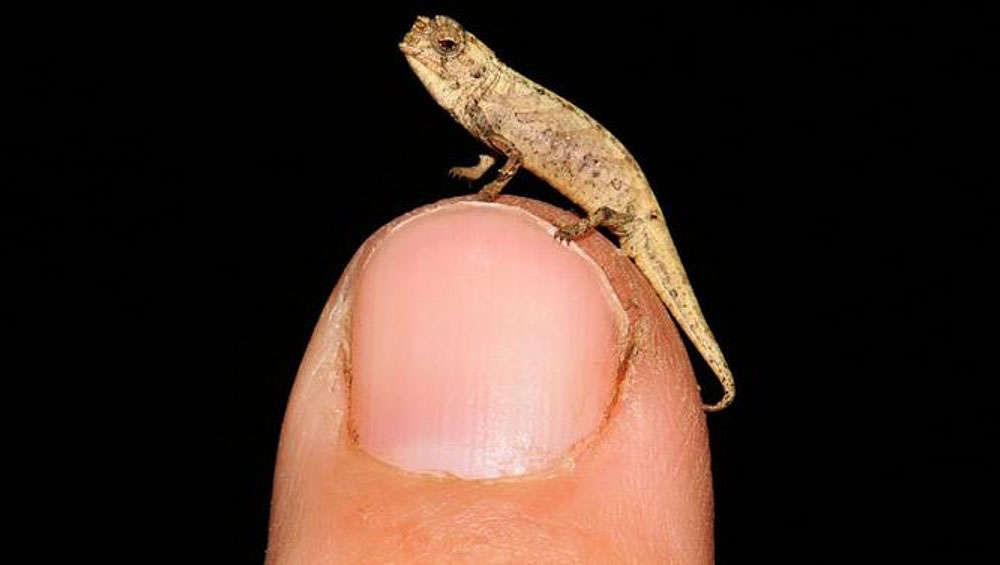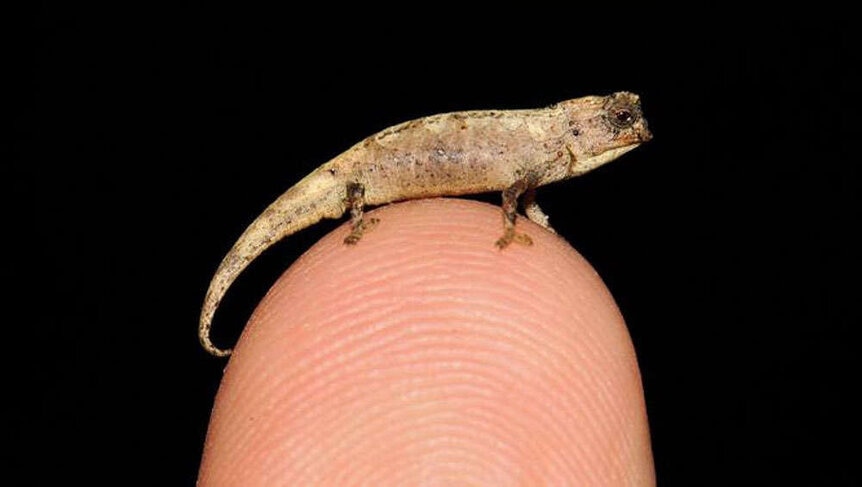Create a free profile to get unlimited access to exclusive videos, sweepstakes, and more!
Did we just find the tiniest reptile ever? Nano chameleon may be small, but he’s a hit with the ladies

This is one chameleon that might not even need to change color to hide.
Found—or almost not found—in the mountains of northern Madagascar, newly discovered chameleon species Brookesia nana is tiny enough to make your fingertip look like it has its own ZIP code. The nano chameleon may also be the new title holder for smallest reptile on the planet (and possibly ever). The males are hardly over half an inch long, tail included. The reason behind this extreme miniaturization in B. nana and other teeny Brookesia chameleon species may be their ability to make the most of the resources available to it at that size.
“We expected immediately in the field that Brookesia nana was a new species, given its small size, its distinct differences from the similarly sized Brookesia micra and based on its distribution in the Sorata mountains at relatively high elevations around 1300 m above sea level,” Frank Glaw, Curator of Herpetology at the Bavarian State Collection of Zoology, told SYFY WIRE. “Nevertheless, the genetic studies were an important confirmation for this assumption.”
Chameleons on Madagascar show exceptional genetic diversity, and slightly different surroundings and resources could mean a huge difference, even for tiny lizards. Glaw recently published a study in Scientific Reports after confirming this was in fact a species that has never been seen before. B. nana was initially assumed to be related to Brookesia micra, another miniaturized species whose scientific name makes its size, or the lack thereof, pretty obvious. Ironically, the tiniest known chameleon is most closely related to the largest of the miniaturized Brookesia species, B. karchei. This species crawls around at lower elevations on the same mountain range. Genetically, they still don’t have that much in common.
Madagascan reptiles and amphibians can get drastically different from each other depending on which elevation level they live on in the island's mountains. Lowland species closely related to highland species have been found before, and that might be the case with B. nana, which may be most closely related to B. karchei but have strongly differentiated DNA.
Evolution doesn't stop when species differentiate. An organism has to do everything it can to stay alive, and food is one of the determining factors of how that organism will continue to evolve so future generations can survive. B. nana may have gotten so nano because the smallest individuals tended to thrive in an area where food was scarce, while B. karchei might have had more of a food advantage.
“After their separation into different species, there might have been a selective pressure in B. nana that favored small body size, perhaps due to limited food resources,” Glaw said. “On the other hand, a greater availability of resources in lowland forest might have favored a larger body size. However, competition with related species in the same habitat could also play a role so that we can only speculate about the actual reasons for the remarkable size difference between B. karchei and B. nana.”
The male B. nana’s reproductive expectations are way bigger than its size. Females are larger than males, a phenomenon known as reverse sexual dimorphism. Glaw believes they would have not been able to handle laying eggs if they got any smaller, so they must have stopped miniaturizing at a slightly larger size, while males continued to shrink. The males adapted to this in their own way. The male B. nana specimen he and his team found proved to be no juvenile, which was obvious from its genitals. While B. nana has testes inside the body, its double hemipenes, which all other reptiles also have in pairs, are outstandingly huge relative to its size and give the male B. nana a fighting chance to successfully mate with females.
That would be why the smallest chameleons have the, uh, biggest packages. B. nana’s hemipenes take up 18.5% of their body size. It doesn’t even win where size matters. Another species, Brookesia tuberculata, has hemipenes that are a third of its body size. It would be nearly impossible for a human to walk around while carrying that. B. nana’s exceptional equipment may be the best mechanical fit for breeding, but could it impress females in some sort of bizarre mating ritual? That remains a mystery. Nobody knows what else these creatures do to get in the mood, not even Glaw.
“At present, we know almost nothing about the courtship, mating systems and reproductive traits of these miniaturized species,” he said. “But I am sure that there remains very much to discover!”



























